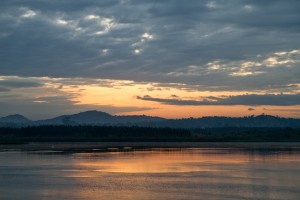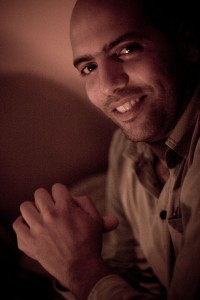Life hasn’t always followed the exact course Seattle sing-songwriter Robert Deeble has thought it would. It’s even been painful sometimes, and required taking a long break to focus on family and self. But it’s led Deeble to deeper understandings about what it means to be human, and about change. After several years away, Deeble decided in 2011 to return to the studio and turn this wisdom into the album Heart Like Feathers, which releases on Feb. 7.
 As with his earlier recordings, Deeble’s latest full-length album lulls listeners into a beautiful world of gentle, lazy-sounding guitar, and vivid lyrics that are honest and sometimes even slightly haunting. There’s sadness in many of the songs, but it’s ultimately a triumphant story about finding one’s self and cherishing relationships. Featuring Deeble and the contribution of many of his longtime friends, Heart Like Feathers sensitively captures the shades of life’s pain and joy.
As with his earlier recordings, Deeble’s latest full-length album lulls listeners into a beautiful world of gentle, lazy-sounding guitar, and vivid lyrics that are honest and sometimes even slightly haunting. There’s sadness in many of the songs, but it’s ultimately a triumphant story about finding one’s self and cherishing relationships. Featuring Deeble and the contribution of many of his longtime friends, Heart Like Feathers sensitively captures the shades of life’s pain and joy.
Deeble spoke with Apsara about the album, his life and music, and about his enduring friendship with Emily Dickinson.
You’re originally from Long Beach, but have lived in Seattle for several years. How have these two places influenced your music, and as a musician do you identify more with one?
I never felt at home in California, although I have a soft spot for San Francisco and Long Beach. Rainy dock towns better match my personality and also my heritage (my family traces back to Wales). I think I was alluding to this in the “Boy with the California Sun” (Thirteen Stories).
The new album’s title refers to Emily Dickinson’s famous poem “Hope is the Thing with Feathers,” and the poetess even appears in a song on Thirteen Stories. What is the significance of your latest album title, and has Emily Dickinson had a larger influence on your music?
Emily just sort of came along for the ride in my career. We met in the song the “Secret Life of Emily Dickinson” (Thirteen Stories) after I was introduced to her in a poem by William Carlos Williams.
From there Emily and I learned a bit about each other, and grew to appreciate each other over the years. Her phrase “Hope is the thing with feathers” is one I probably conjured subconsciously in the title of the record. I had been writing what would become the title track when I fell into the phrase “Heart Like Feathers,” which perfectly described what I was trying to say. The song is about the battle between the head and the heart, with the heart gradually getting free. It was later as I read a review by Image Journal of the record that I realized the similarity to Emily’s poem, so it is nice to know she is still hanging out with me.

What are some of the most important elements from the past six years listeners can find in the songs on Heart Like Feathers?
It is a very human record yet one that tips its hat to the spiritual, but always in an earthly manner—not in a dissociated way. The material covers a lot of very real struggles from depression, marital issues, fear, and anxiety, with some slivers of light that finds its way into those dark places.
Was This Bar Has No One Left, your previous shorter release, part of the creative process leading up to your new album?
Yes, that really is the preface to Heart Like Feathers. In my mind it was supposed to be one record, but then it started as an EP which was supposed to move into a full length—life does not work the way we plan. The EP came out and I traveled extensively supporting it, but I felt things beginning to slip in my life. It started with my label but soon afterwards my life seemed to show the cracks of potential collapse. I think I started to see my life as a reflection of my art instead my art as a reflection of my life. I needed to take some time off and reboot. I found myself shutting down, retiring a band, and stopping writing for awhile.
I spent the time during that hiatus rebuilding who I was at home more than who I was on the road. This included paying more attention to my marriage and the changes in myself as a man, and I eventually found a restorative way to reintegrate my artistry.
Who are some of the key individuals who lent their creativity and voices to Heart Like Feathers?
Well there are a lot of them starting with a new band. About three years ago, I gradually started writing and playing with some guys that I had built really good relationships with. All us are in committed relationships and most of us have children, which always makes a band more difficult but I like how it reflects who I am as a person. Naturally we all make significant sacrifices to be in a band together and yet we all totally respect how not to let it compete with the rest of our life. As I got older, I wanted to integrate the two and be with others who were in the same boat.
So for the band it is: Jeremy Summer (also part of the Whiskey Swillers) on bass; Jeremy Dybash (an original member of Velour 100) on drums; and Neal Vickers on guitar and strings. And then I flew Lili De La Mora, my backing vocalist, up from California to record the album.
Our producer was Dylan Magierek, who runs Badman Recording Co. Dylan had come to see several of my shows over the years when I was on tour. And I have always loved the kind of artists he associates with, so it seemed fitting to ask him to be a part of he project.
Then there is an amazing array of guests on the album. It meant a lot to me that so many folks would come out of the woodwork to celebrate a new album with me. Stephen Hodges, who plays percussion,was my musical mentor over the years. He currently drums for Mavis Staples and was known as Tom Waits’ drummer during the Rain Dogs years. Victoria Williams, one my favorite folk heroines, returned to join me on the song “Sunflower.” Ric Hordinksi (Monk), originally from Over the Rhine, had a big part in encouraging me to write and record this record and he offered up two guitar tracks for the album. Anna-Lynn Williams (Trespassers William) is an old pal from my California days and she did an amazing vocal with on the song “Undertow.” And lastly, we pulled a choir together with some great friends from over the years. Daniel G. Harmann, Kate Tucker, John Vecchiarelli, and Adam Selzer—just to name a few—are all some wonderful folks from my musical past that came together to sing on the last track.
Most of the sessions were filmed by two great film makers: Todd Zeller and Tommy Harrington. So we got a lot of great footage of the album, which we hope to feature on a limited edition CD.
“Sun Flower”
Here comes the bird to eat the worm,
but he’s hiding ‘neath the corn
Big black cat hanging underneath the tree,
waiting for the bird to meet
Sunflower,
where did you go?
Sunflower,
did you know?
Humming bird never hurt no one,
troubadour strayed away from home
All of life under love and toil,
two hands digging in the soil
There’s a garden in our souls, we forget to water
all those storm clouds coming north
I guess we’ll get that shower
So rise up now… let’s shine
Sunflower
I miss you so
Sunflower did you know?
Desert storm across the plains
we dug a ditch to direct the rain
Bright red tractor in the mud
teach us to tinker with a flood
And I just got your weather report
I’m so sorry about it girl
All those dark clouds around your porch
I think they’re blowing over
Let’s rise up now and shine




